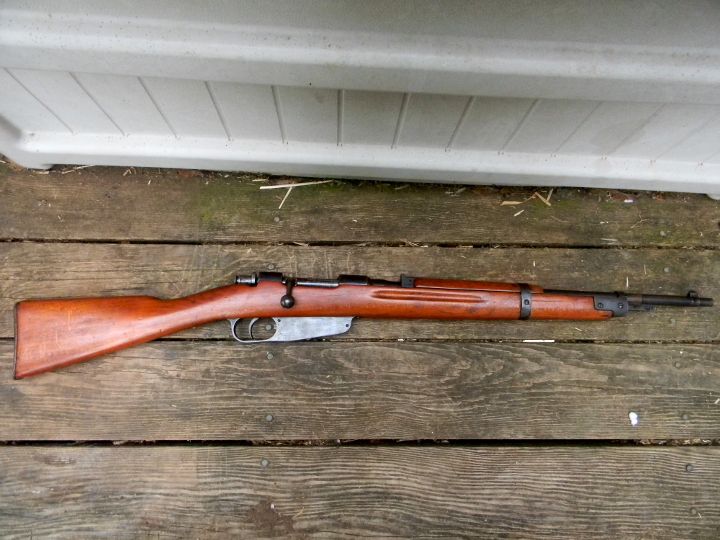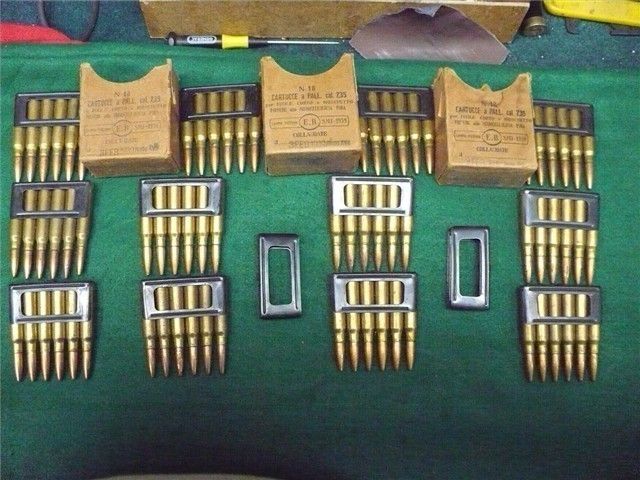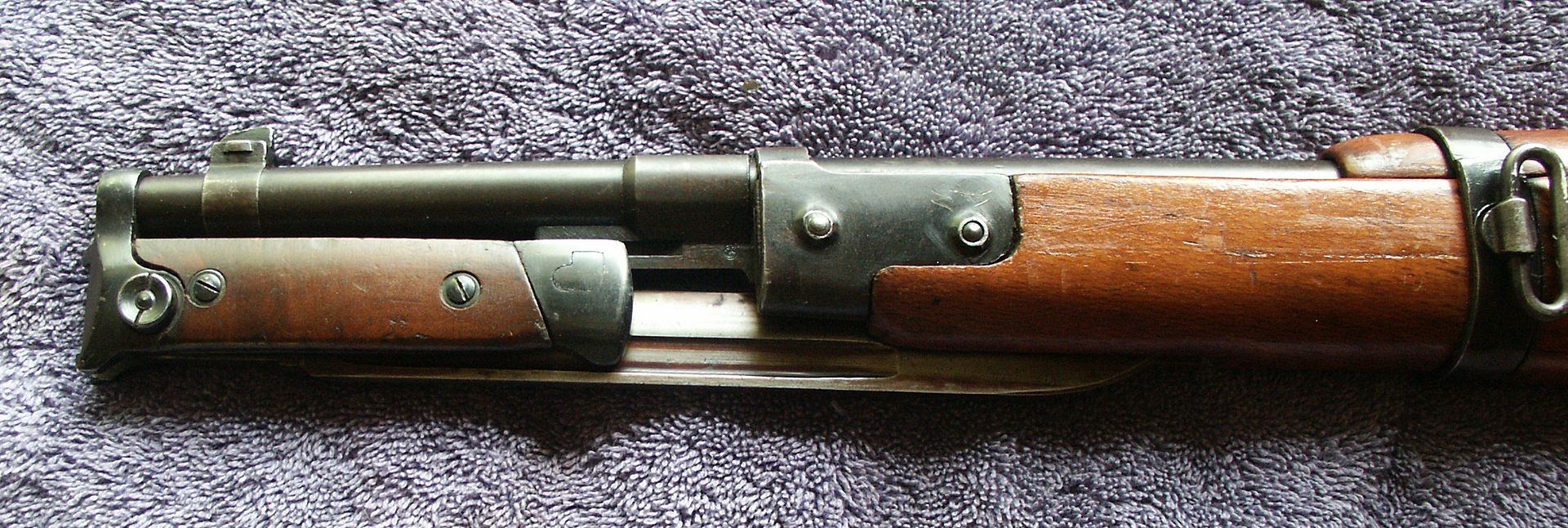I inherited a 7.35 mm Carcano and have read very mixed reviews on how safe these rifles are. While looking for ammunition, one gun shop employee said they were generally a very unsafe gun and he wouldn't recommend shooting it. I took it to another gun shop and the owner/gunsmith said they used to sale them and they were good guns. He briefly inspected it and said it was fine. He even had some reloads for it. I then took it to another gunsmith, who thoroughly inspected and said it was fine. We then went out and shot it. I have fired it about ten times with no problems. But i have read all kinds of negative reviews on the internet. Does anyone have any experience with these rifles, good or bad?
You are using an out of date browser. It may not display this or other websites correctly.
You should upgrade or use an alternative browser.
You should upgrade or use an alternative browser.
7.35 mm Carcano
- Thread starter AL45
- Start date
What the folks who told you Carcanos are unsafe forgot to tell you is that they don't know what they were talking about. In general, no government wants their soldiers firing anything unsafe, no matter how lowly the soldier is. Bad for morale, you know. And the Carcano was one of the few actions PO Ackley could not blow up when he was testing actions to failure. Is it pretty? No. Marvel of engineering? No. Strong? Yes, at least as strong as it needed to be.
Rainbow Demon
New member
The Italian Carcano got a bad rap due to some extremely degraded WW2 or earlier manufacture milsurp ammunition imported from Egypt.
The propellent used for Carcano ammo was a high nitroglycerin content (60%) powder and when stored in a hot climate for years the powder seperated and clumped up forming a plug of gunk with high explosive properties as dangerous as sweating dynamite.
There were some late war production rifles with poorly heatreated studs on the cocking piece, these could shear through if a case ruptured and the cocking piece might hit the shooter in the face.
If a Carcano is in good condition its as safe as any 1890's bolt action design and safer than many of its contemporaries.
One should examine the cocking piece for signs of excessive wear.
The Finns did not like the Carcano, which added to its undeserved bad rep, but the Finns complaint was mainly about the non adjustable rear sight of the wartime production rifles.
Also the Cacano's converted to 7.92mm may not have held up well if fired using the extra hot heavy ball and AP cartridges for the LMG which were often too hot for a K98 and could cause lug setback.
Due to ammo shortages some Luftwaffe ammo ended up on the infantry lines. Some of that ammo was loaded to 60% higher chamber pressure, as hot as a proof test load. Some obsolescent Luftwaffe beltfed aircraft MGs were modified for ground use and their specially belted and extra hot ammo ended up on the front lines as well.
The propellent used for Carcano ammo was a high nitroglycerin content (60%) powder and when stored in a hot climate for years the powder seperated and clumped up forming a plug of gunk with high explosive properties as dangerous as sweating dynamite.
There were some late war production rifles with poorly heatreated studs on the cocking piece, these could shear through if a case ruptured and the cocking piece might hit the shooter in the face.
If a Carcano is in good condition its as safe as any 1890's bolt action design and safer than many of its contemporaries.
One should examine the cocking piece for signs of excessive wear.
The Finns did not like the Carcano, which added to its undeserved bad rep, but the Finns complaint was mainly about the non adjustable rear sight of the wartime production rifles.
Also the Cacano's converted to 7.92mm may not have held up well if fired using the extra hot heavy ball and AP cartridges for the LMG which were often too hot for a K98 and could cause lug setback.
Due to ammo shortages some Luftwaffe ammo ended up on the infantry lines. Some of that ammo was loaded to 60% higher chamber pressure, as hot as a proof test load. Some obsolescent Luftwaffe beltfed aircraft MGs were modified for ground use and their specially belted and extra hot ammo ended up on the front lines as well.
madcratebuilder
New member
one gun shop employee said they were generally a very unsafe gun and he wouldn't recommend shooting it.
You encountered a ignorant gun shop employee.
Both the 6.5 and 7.35 Carcano is safe to shoot, just follow common sense, make sure it has correct head space, barrel/bolt is reasonably good condition.
Surplus 6.5 ammo is generally very poor. The 7.35 is better if it has been stored properly.
7.35




Mike Irwin
Staff
"There were some late war production rifles with poorly heatreated studs on the cocking piece, these could shear through if a case ruptured and the cocking piece might hit the shooter in the face."
It was my understanding that the Italians stopped manufacturing 7.35 rifles in 1941 because they were running into major logistical problems. They couldn't manufacture enough 7.35s to arm all of their military, and they couldn't work out the supply issues of getting 6.5 to those troops who needed it and 7.35 to the others, so they started pulling the 7.35s back and rebarreling them to 6.5.
It was my understanding that the Italians stopped manufacturing 7.35 rifles in 1941 because they were running into major logistical problems. They couldn't manufacture enough 7.35s to arm all of their military, and they couldn't work out the supply issues of getting 6.5 to those troops who needed it and 7.35 to the others, so they started pulling the 7.35s back and rebarreling them to 6.5.
+1 Scorch
I have fired my share of the Carcanos and have heard all the negativity you can imagine of these fine rifles. Most of it is BS
Some of the negativity is a result of using ammo of the wrong bullet diameter plus correct ammo is difficult to find.
The 7.35 bullet diameter is .300 and the 6.5 is .268. With reloads, Carcanos can be extremely accurate.
I have fired my share of the Carcanos and have heard all the negativity you can imagine of these fine rifles. Most of it is BS
Some of the negativity is a result of using ammo of the wrong bullet diameter plus correct ammo is difficult to find.
The 7.35 bullet diameter is .300 and the 6.5 is .268. With reloads, Carcanos can be extremely accurate.
Thanks for your replies. My Father In Law never got to shoot it because he could never find ammunition. I wasn't sure how safe it was and never helped him find it. After he passed away, I remembered the rifle and researched it to find out about it. I found some ammunition that the local gun shop had produced by necking brass from another caliber to the 7.35mm. As I understand, the gun was sighted in at 300 yards, and the soldiers were trained to fire at the enemies belly. If the enemy was actually 200 yards away, it would hit the chest and if they were 100 yards away it would hit the head.
Romeo 33 Delta
New member
And, the Italians were taught a different sight picture from that which we are used to (pumpkin on the post). They were taught to bury the front sight blade into the bottom of the rear sight "V". You'll still need to aim low at shorter ranges.
Carcanos are FUN rifles ... if you get into reloading for them ... even MORE fun.
Carcanos are FUN rifles ... if you get into reloading for them ... even MORE fun.
Rainbow Demon
New member
Carcano bolt disassembly video.
http://www.youtube.com/watch?feature=endscreen&NR=1&v=V1mu2dlafG4
http://www.youtube.com/watch?feature=endscreen&NR=1&v=V1mu2dlafG4
easttxcountry
Inactive
Crimp on 7.35
my brother acquired a 7.35 Carcano and I've already located brass and 128g Hornady SP's for it and the dies from Graf's, however I cannot find any information on what kind of crimp this round likes. I also cannot find any load information for this round. any help would be greatly appreciated.
my brother acquired a 7.35 Carcano and I've already located brass and 128g Hornady SP's for it and the dies from Graf's, however I cannot find any information on what kind of crimp this round likes. I also cannot find any load information for this round. any help would be greatly appreciated.
Mike Irwin
Staff
I wouldn't even bother to crimp the rounds.
Recoil isn't all that heavy, so the bullets shouldn't move in the cases.
As for loading information, this is what LoadData.com has to say about the cartridge. I can't vouch for any of it, so you are on your own.
https://www.loaddata.com/members/se...berid=49&header=7.35mm Caliber Reloading Data
Recoil isn't all that heavy, so the bullets shouldn't move in the cases.
As for loading information, this is what LoadData.com has to say about the cartridge. I can't vouch for any of it, so you are on your own.
https://www.loaddata.com/members/se...berid=49&header=7.35mm Caliber Reloading Data
tahunua001
New member
the problem with guns stores is 'every guy behind the counter is an expert at everything'. a lot of them tend to talk out the wrong end about stuff they don't know. the last time I was at a cabelas, and this has been over a year ago now, I spent a great deal of time in the used gun racks. there were over 2 dozen carcanos, mostly in 6.5x52mm but some 7.35s and a couple of the 8mms. none of them looked all that great. the wood was about the same quality as driftwood. some but not all had been sporterized and pretty poorly by my reckoning. this was enough for me to look into them and see why so many of them were sitting in used gun racks instead of part of a collection.I inherited a 7.35 mm Carcano and have read very mixed reviews on how safe these rifles are. While looking for ammunition, one gun shop employee said they were generally a very unsafe gun and he wouldn't recommend shooting it. I took it to another gun shop and the owner/gunsmith said they used to sale them and they were good guns. He briefly inspected it and said it was fine. He even had some reloads for it. I then took it to another gunsmith, who thoroughly inspected and said it was fine. We then went out and shot it. I have fired it about ten times with no problems. But i have read all kinds of negative reviews on the internet. Does anyone have any experience with these rifles, good or bad?
the ammo is very difficult to find and the little surplus that did make it here after the war isn't that great. reloading for both cartridges is a pain because Italy used nonstandard bullet diameters. 6.5 carcano uses a .268 diameter bullet while every other 6.5 around from 6.5 japanese arisaka to 6.5 grendel uses a .264 diameter bullet. 7.35 carcano uses a .299 diameter bullet while all other 30 cals use 308-311 diameter bullets so it is incredibly difficult to reload for them. not long ago i went in with some other guys and bought a large reloading collection from a woman who's husband had passed away and in it he had over 1400 .299 diameter bullets. those things were the hardest things in the world to get rid of because of the few 7.35s that are out there, few people actually shoot them because of how hard it is to find reloading components and loaded ammo.
there is no inherent safety risk to shooting a carcano in either original cartridge. the only ones you have to look out for are the ones that the nazis captured and converted to 8mm mauser as a desperation move.
I still have an old Hornady Handbook Volume 2 loading manual from 1973 that has load data for the 7.35X52 with IMR 4198, 3031, 4064, 4895, 4320, and Hodgdon H380. If you were planning to use any of those powders and need data, PM me.I also cannot find any load information for this round.
FWIW, I have one of those Carcanos converted to 7.9. I fired it a couple of times with German sS ball with no problem, but I did so carefully as the larger cartridge not only has a greater working pressure than the original rounds, but the larger physical size of the 7.9 round reduces the amount of metal in the barrel and receiver.
I would have to say the gun didn't blow up or do anything else wrong, but I do NOT recommend firing them. The Carcano, in its original calibers, is actually not a bad gun.
I once said that if I had been a soldier in 1891, I would have preferred a Carcano to the rifle the U.S. Army was using at the time, the trapdoor Springfield.
Jim
I would have to say the gun didn't blow up or do anything else wrong, but I do NOT recommend firing them. The Carcano, in its original calibers, is actually not a bad gun.
I once said that if I had been a soldier in 1891, I would have preferred a Carcano to the rifle the U.S. Army was using at the time, the trapdoor Springfield.
Jim
Mike Irwin
Staff
Midway offers newly manufactured soft-point bullets for the 7.35, 128-gr.
http://www.midwayusa.com/find?sortby=1&itemsperpage=24&newcategorydimensionid=16198
I don't see brass at Midway, but I believe you can simply neck expand 6.5x52 Carcano brass and trim, if necessary.
Cartridges of the World says to use 6.5x54 Mannlicher brass.
http://www.midwayusa.com/find?sortby=1&itemsperpage=24&newcategorydimensionid=16198
I don't see brass at Midway, but I believe you can simply neck expand 6.5x52 Carcano brass and trim, if necessary.
Cartridges of the World says to use 6.5x54 Mannlicher brass.
